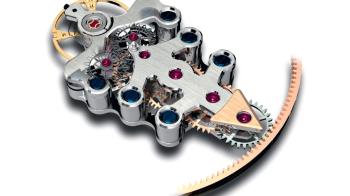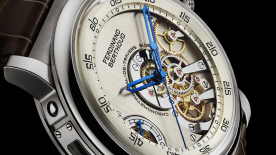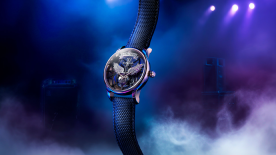Back in 2001, watchmaking appeared to be resting firmly on the same foundations as 180 years previously, when Mr. Lépine invented the movement structure bearing his name. A baseplate underneath, wheels and a barrel in the middle, bridges on top. Around 1845, Adrien Philippe, co-founder of Patek Philippe, invented the crown to replace the cumbersome keys. Then Ulysse Nardin came up with the Freak and did away with all that.
Look, No Hands
One: it’s got no crown. Time-setting is done via the notched bezel once it’s unlocked by lifting a lid between the lugs and winding through the notched caseback. Two: its movement’s stacking is all over the place. At the back lies the barrel, the mainplate sits in the middle and there are no covering bridges in the traditional sense. Three: it’s 44.5mm wide and 12mm thick. Four: it has no dial, so it looks mostly hollow. Five: it has no hands. Six: the gears and their bridges, including those of the balance, are one giant moving part. This in-line conformation is the minutes’ hand. Seven: this means that the whole gear train, escapement and balance rotate at the rate of one cycle per hour. Eight: the hours are a revolving disc one level below.
A Wider Sense of Rotation
The Freak is a carrousel (not the kind Bonniksen meant known as a karussel, but in the merry-go-round sense). And it’s also a tourbillon, isn’t it, since its balance is housed in a revolving structure? The latter is not a cage per se, but then again, nothing about the Freak is per se. Everything is ad hoc. So if the Freak is a tourbillon, it’s a one-hour tourbillon. That’s very far off the one-minute rhythm that has become the norm. That’s a lot to be able to claim efficiency. Remember that the tourbillon makes an average of all positions. The greater the variety and speed at which said positions are achieved, the better the average. Here we have a very low speed, so mathematically, not a good average. Yet, it is a tourbillon because no one ever put a limit, lower or higher, to what the speed of the cage should be. And it is a tourbillon because, as Galileo put it: “Eppur, si muove,” (and yet it moves). This is an endless debate, so let’s shift the conversation to the matter of origins, and what the Freak allowed, liberated and accelerated.

The Origins
In 1997, a very young and gifted French watchmaker, Carole Forestier, developed the “Carrousel Central” calibre concept for a Breguet competition. Instead of lodging the balance inside a rotating cage, she made the whole movement revolve around a central axis like a tourbillon. And around it all was the mainspring. Later, she introduced the concept – which was already something of a tsunami in a “don’t-stray-from-tradition milieu” way – to Ulysse Nardin. They realised it couldn’t be manufactured as such, as it couldn’t store enough energy to feed the very power-hungry rotation. So Ulysse Nardin’s chief technical officer, Ludwig Oechslin, took over the concept and turned it into a movement, where the revolving structure rests above a spring as large as the movement. Mr. Oechslin was at his most creative back then and had the full trust and backing of the brand’s visionary owner, Mr. Rolf Schnyder. They ended up making the Freak even more innovative.
Freakier by the Year
On top of it all, the Freak was fitted with a dual impulse escapement, called Dual Ulysse, which was the first ever to be made of silicon. It was later produced in synthetic diamond for the Freak Diamond Heart and subsequently endowed with a silicon escapement coated with synthetic diamond, the Freak DIAMonSIL. The Freak Diavolo was subsequently endowed with a proper tourbillon – flying to boot – in lieu of the balance, which made it a double tourbillon (with cage rotation speeds of one minute and one hour). After that they started to change the shape of the going-train bridge/minutes’ hand, later adding a date, before stripping the structure, moving the barrel back inside the movement and introducing the slimmer Freak X. By then they had used it twice as a technical innovation platform, the Innovision 1 and 2, showcasing a boatload of new manufacturing and watchmaking techniques. Next came the Freak Next with its fantastic oscillator, before they finally turned the crazy down.
Even More Momentous
That’s not the Freak’s only legacy. Clever rather than freakish, it really was a trailblazer. It broke the dam and inspired dozens of watchmakers who discovered that all is not set in stone. That timepieces are a wide expanse where daring minds can do just about anything. And so they did, in a freakish, fruitful way.





